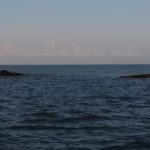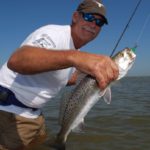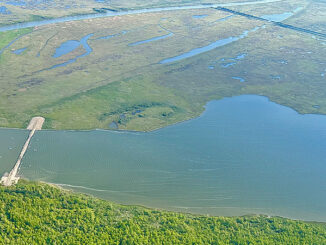
In the once-disputed territory along the lower Sabine River, big speckled trout await. Here are some tips on how to put them in the boat.
No Man’s Land!
It has a romantic ring to it.
Most people who can associate it with anything do so with World War I, when it was used to describe the land between the trenches of the opposing armies in Europe. But before the term was ever used in the Great War, as it was then called, it was used in Louisiana.
When the United States made the Louisiana Purchase, both of its borders with Spain were unclear. What are now the Florida Parishes were claimed by Spanish-held Florida. The western boundary was disputed by Spanish Mexico.
The Spanish held that a wide strip of land, from the current Louisiana-Texas border to the Calcasieu River and Bayous Kisatchie, Don Manuel, Lac Terre Noir and the Arroyo Hondo was theirs from what is now Sabine Parish in the north, south to the Gulf.
Of course, the United States maintained that they owned the area.
As a result, neither nation policed the area and it rapidly became a haven for desperadoes, outlaws, deserters, fortune hunters and ruffians of every stripe.
Besides No Man’s Land, it was called the Sabine Free State, the Neutral Ground or the Neutral Strip. Blood flowed freely until “pacification” in 1822.
I was here to draw blood, too — speckled trout blood.
Sabine Lake has always been kind of a blank spot for me, a blue blotch the state map. It is tucked away in the least-populous corner of the state; it has few fishing support facilities; no one writes about it.
It was late in the summer and Capt. Jerry Norris, widely acknowledged as the man who put Sabine Lake on East Texans’ fishing destination map, was scowling as he ran his boat south in Sabine Pass heading for the jetties, a prime summertime speckled trout fishing location.
His eyes were fixed on a huge malevolent cloud formation towering up out of the Gulf of Mexico directly ahead of us. The early morning sun, invisible to us, backlit its evil, cobra-shaped head and infused its gray with a sickly peach color.
Lightning flashed wickedly, as if warning us not to go farther.
“Waahl, that don’t look good,” Norris drawled laconically in his East Texas twang.
He kept heading south, but the look on his face expressed concern.
To call the jetties impressive was a massive understatement. They were the mother of all jetties, and seemed to stretch to eternity — beyond sight — into the Gulf of Mexico. Unlike other jetties with their rocks tumbled in willy-nilly fashion into a wall, every massive rectangular granite block was arranged with its neighbors like a jigsaw puzzle.
They were not only the longest jetties I had ever seen; they were the prettiest, as well.
What wasn’t pretty was the wild spray pitching 20 feet into the air as massive rollers spawned by the rapidly forming tropical depression in the Gulf smashed into the east jetty wall.
Scrub one trip.
But I was intrigued.
Nineteen days later I was back and really pumped up. Norris promised to wade-fish in the surf, one of my great loves.
“During September and October, we have some really good surf fishing here,” he said. “Most fishermen are up in the lake [Sabine] chasing trout under birds, but the bigger fish are down in the surf.”
The morning was beautiful, with a virtually cloudless sky and a gentle east wind. Two cool fronts had passed over since my last trip here. The September air had a distantly cool edge.
Part-way down the impossibly long eastern jetty, Norris slowed his boat and eased it through a “boat cut” in the wall of mega-ton rocks, and then jumped it back on step heading directly for the beaches on the Louisiana shore to the north.
When he neared the beach, he turned parallel to it and coasted the boat eastward under just enough power to keep it on plane.
He scrutinized every inch of water between him and the beach as he rode. He was looking for sign — something to indicate fish. Frequently, he slowed to an idle for a better look at something that interested him.
“The water is pretty fair,” he said. “I’m looking for mullet. Also feeding slicks and pogy schools. I can smell feeding slicks. They smell like fresh-cut grass or cut watermelon — ya know?”
Birds working, diving on schools of bait species being attacked by predator fish like trout will get his attention too.
“When all else fails, you just fish,” he muttered.
As he moved down the beach away from the jetties, the water changed color.
“It’s a little dingy here, but I’ve caught fish in here when it was just filthy,” Norris said. “There’s a slick down there. Kinda tells you where they are. Fish spit up a lot of what they eat, and the oil comes up with it. The smaller the slick is, the closer you are to the fish.
“What you look for is pie-plate size. The longer the slick is up, the bigger it gets and the farther the wind and current move it from the fish.”
He saw something he liked because he stopped the boat. After anchoring it, he climbed over the stern, toting a fish basket suspended from a foam ring. On top of the ring were two plastic bait boxes — everything he needed at his fingertips.
Tied on the end of his line was a 5-inch, soft-plastic fire-tiger Bass Assassin straight-tail. Before his first cast, and often throughout the day, he whipped out a squeeze bottle of Catcher Company shrimp-flavored Smelly Jelly Sticky Liquid and put some on his lure.
“There is a story behind that,” he explained. “One day we were fishing live shrimp on the east jetty and couldn’t get a bite. A fella in a boat next to us was wearing them out on plastic. I asked what he was using as he was leaving, and he tossed me a bottle with a little in it.
“He said, ‘Here, take it. I’m done.’ I’ve been using it ever since. I order it directly from the company by the case.”
In spite of the presence of large numbers of small baitfish flickering on the water’s surface, a 50-yard casting patrol from the boat produced no hits. Wading purposefully back to the boat he explained, “I don’t stay long in a spot; I move.”
Another stop farther up the beach produced the same result. It was 7:45 a.m. and the tide was still falling. After a little more scouting, the veteran guide ran back to the jetty walls and began fishing them, trolling the boat parallel to the wall and firing in casts diagonally toward it.
It seemed obvious that he was killing time, but the interlude gave the quiet man a chance to talk.
“I fish all over Sabine,” he said, “but I like wading the surf best. I catch a lot of fish, and the fish are real aggressive. And I can get away from people there.”
Norris has to fish in all conditions because he has clients, but there are particular times when the odds of success increase.
“I fish on any tide because I am a guide. I just go fishing and deal with it,” he said. “But the best time [on the beach] is any time I can catch the last of an incoming tide and the first of an outgoing tide. That is the best time overall to catch fish.
“I would rather not fish a dead-low tide changing to an incoming. I don’t like a tide with a lot of range, either — they switch too fast. The ideal is about a foot of range.”
He continued his tutorial, noting that he always likes an increasing moon after the new moon, especially the week before the full moon.
For surf fishing, a north, northeast or light southeast wind is best. For fishing the jetties, any direction of wind will work if it is light. In the lake itself, a southeast wind is always good.
The poorest wind is west to southwest, although he noted that a hard east wind — anything over 12 to 15 miles per hour — “will mess you up.”
Seagulls wheeling and diving west of the west jetty wall caught his attention and held it until he couldn’t take any more.
After he eased the boat through the cut in the west jetty and saw the action, his shoulders drooped visibly: A school of turbo-sized redfish was bashing up a school of pogies, throwing geysers of water into the air.
And the water is muddy-cruddy.
“It’s what I thought,” he drawled.
This muddy water is usual in this corner of the beach and jetty. There is no current in this area because the jetty has cut it off.
Without making a cast, he turned the boat around, passed through both jetties and eased along the Louisiana beach until he reached a spot he fished earlier in the morning, near an old stranded barge.
While the water was still dingy, something had changed. Gulls, terns and skimmers were screaming and wheeling in the air. The gentle breaking of small waves on the beach was making an inviting “crump” — pause — “crump” sound. The tide had turned and was starting to rise.
Fifteen feet from the boat, the first trout — a solid 17-inch fish — banged Norris’ Smelly-Jellied Bass Assassin. Every few casts produced another fish, bearing out his prediction that action would follow the changing tide.
His strategy was simple.
He waded generally parallel to the beach. Several sandbars where laid out, also parallel to the beach, and he zigzagged from one to the other, casting diagonally both toward the beach and away from it.
He moved at a slow, steady walk until he had a bite, and then he stopped and fished the spot thoroughly before moving on.
“Most of the fish are laying in the gut (the deep water between sandbars) or on top of a bar where the foam is,” Norris said. “You only need 12 inches of water on top of a bar. Sometimes you can see the shadows of the fish.
“The best fishing is usually early in the morning. I like to get here real early and get really shallow. I will cast up onto the beach and retrieve my baits from there. When I get here early, I like to walk and cast toward the rising sun. My theory is that the fish see baits better that way.”
He slipped trout after trout head-first into his floating basket. Few were as small as 15 inches, most were over 17 inches and one hit the 4-pound mark.
Norris cast toward every flicker of activity, not just big blow-ups on mullets, but little things.
“Be vigilant,” he coached. “If you see a mullet swim by throw to that. If you see a shrimp jump throw to that. If you see anything different in the water throw to that. Trout will just swim along with a bait school. When they get ready to eat — they eat. In clear water I’ve seen that with my own eyes.
“Be vigilant,” he repeated after he grunted and set the hook on another speckled beauty. “Be vigilant.”
Editor’s note: Jerry Norris, often called “Mr. Sabine Lake,” is a featured angler in the newly released book “Trout Masters Too: How the Pros Do It” available at the Sportsman Store and on Amazon.com, Norris may be contacted through his guiding business, The Original Sabine Lake Guide Service, by calling 409-718-8782.








